Unit 5 Lesson 29DNA—The Story of You 课件 冀教版英语九年级全册(21张PPT)
文档属性
| 名称 | Unit 5 Lesson 29DNA—The Story of You 课件 冀教版英语九年级全册(21张PPT) | 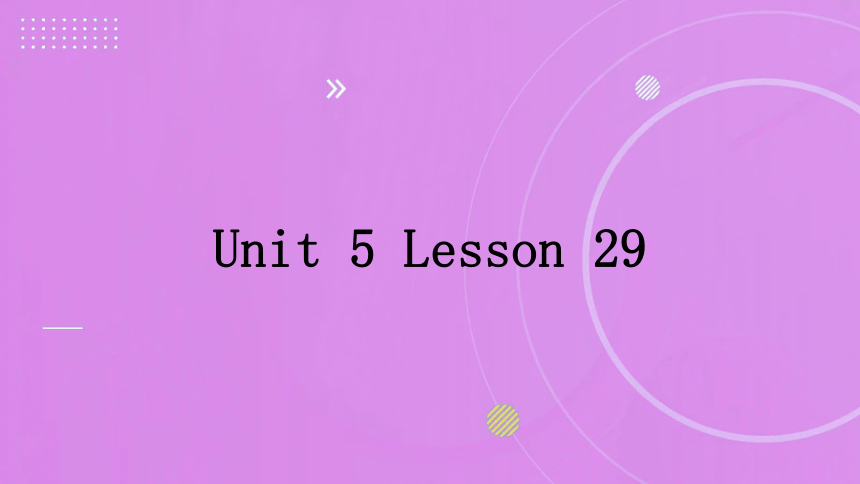 | |
| 格式 | pptx | ||
| 文件大小 | 4.9MB | ||
| 资源类型 | 教案 | ||
| 版本资源 | 冀教版 | ||
| 科目 | 英语 | ||
| 更新时间 | 2024-02-12 08:02:10 | ||
图片预览

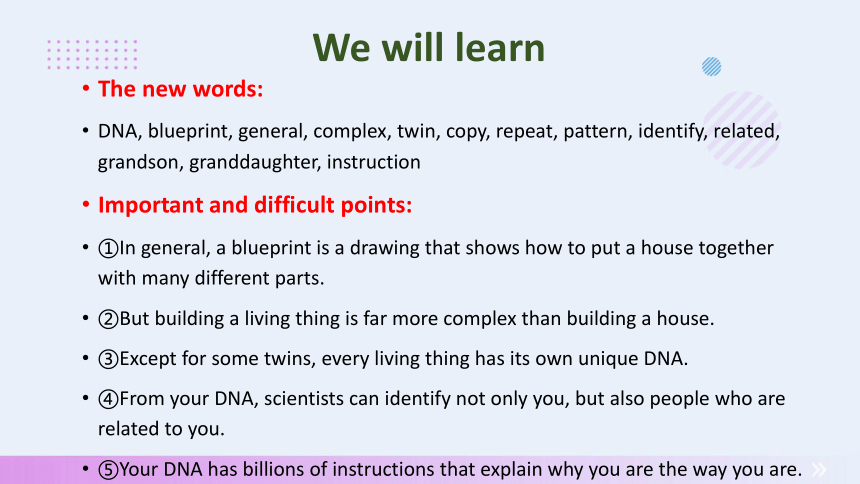
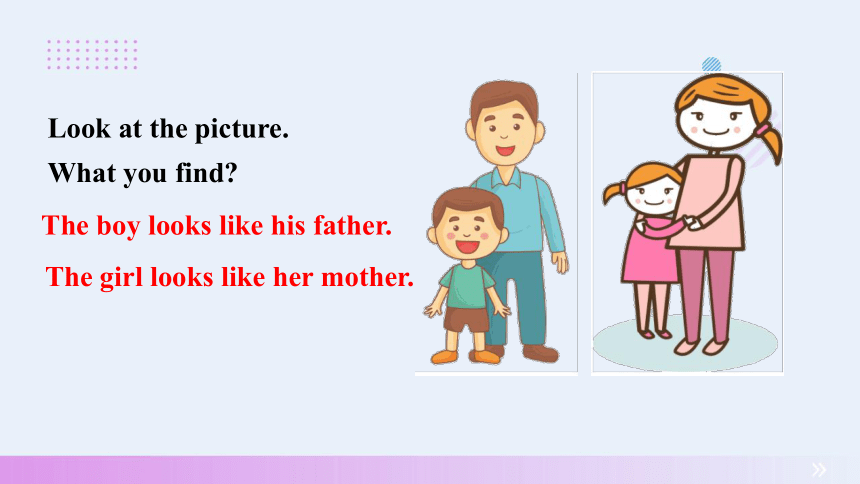
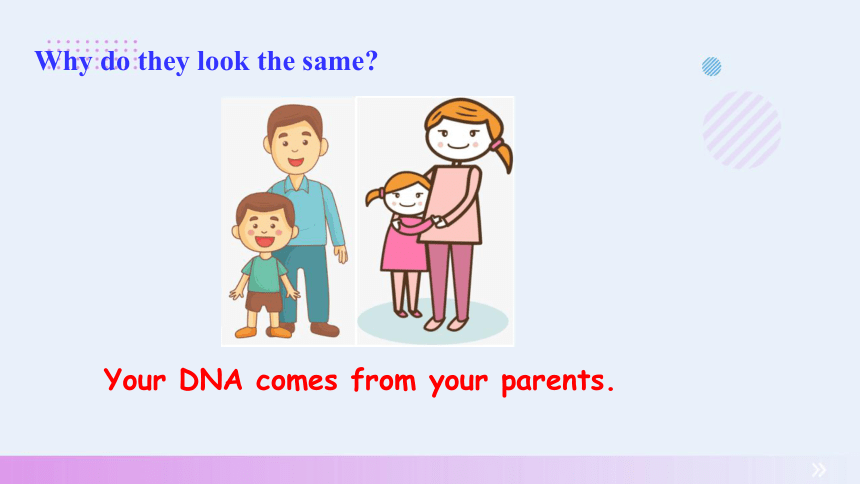

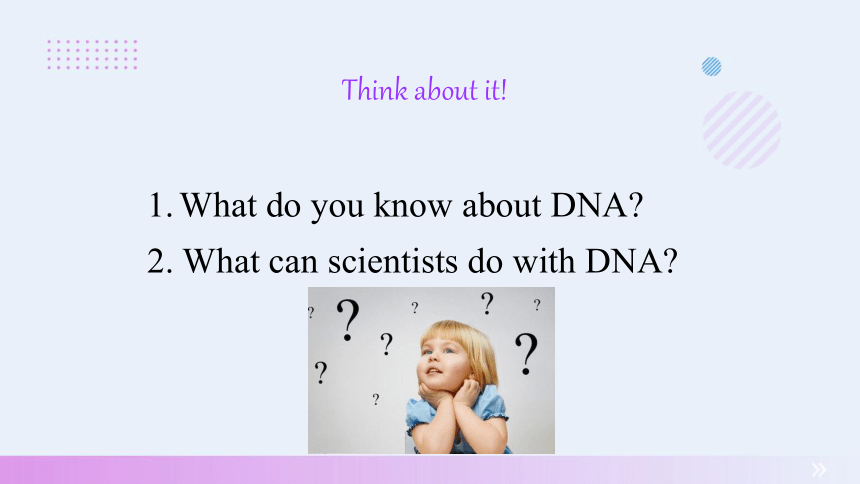
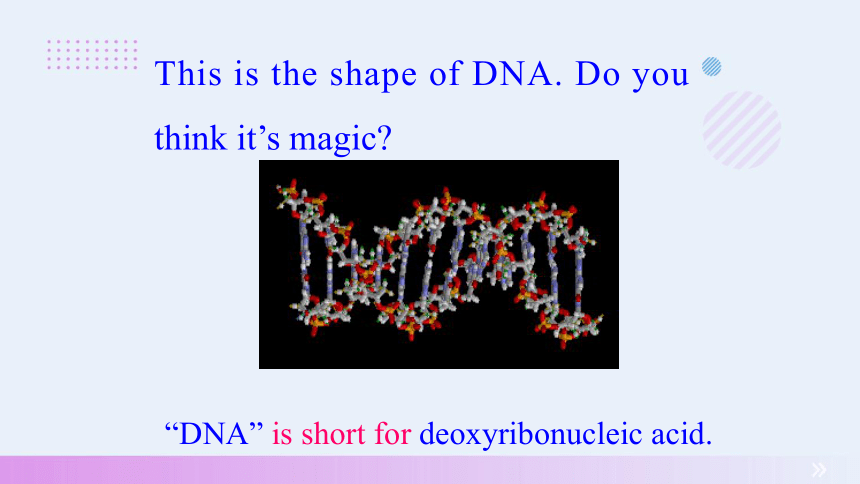
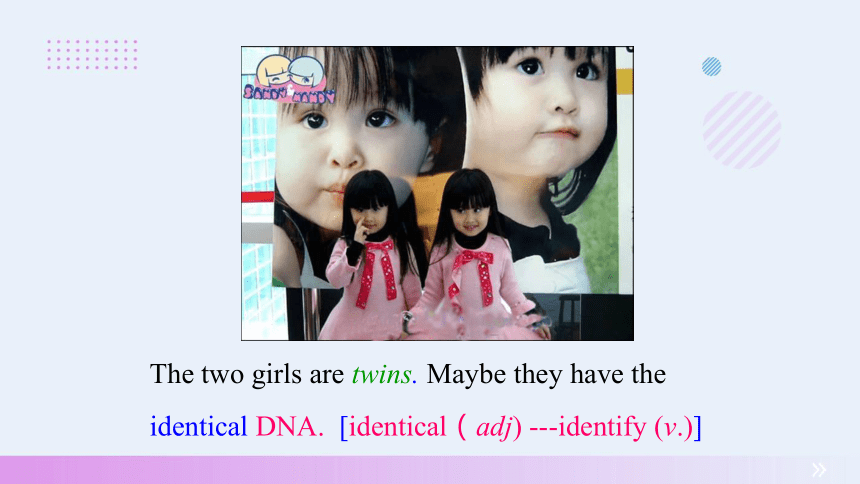

文档简介
(共21张PPT)
Unit 5 Lesson 29
We will learn
The new words:
DNA, blueprint, general, complex, twin, copy, repeat, pattern, identify, related, grandson, granddaughter, instruction
Important and difficult points:
①In general, a blueprint is a drawing that shows how to put a house together with many different parts.
②But building a living thing is far more complex than building a house.
③Except for some twins, every living thing has its own unique DNA.
④From your DNA, scientists can identify not only you, but also people who are related to you.
⑤Your DNA has billions of instructions that explain why you are the way you are.
Look at the picture.
What you find
The girl looks like her mother.
The boy looks like his father.
Your DNA comes from your parents.
Why do they look the same
Do you and the students near you look the same What is the same
Warming up
Lead in
Think about it!
What do you know about DNA
2. What can scientists do with DNA
This is the shape of DNA. Do you think it’s magic
“DNA” is short for deoxyribonucleic acid.
The two girls are twins. Maybe they have the identical DNA. [identical(adj) ---identify (v.)]
Why
Fang Zuming looks like his father—Cheng Long.
What do you know about DNA
Lead in
·What can scientists do with DNA
do with 处理
do with与deal with都可表示“处理”。
do with常与what连用,而deal with常与how连用。
e.g. I don’t know what they do with the problem.
我不知道他们如何处理这个问题。
Lead in
While-reading
Read the lesson and answer the questions:
What is a blueprint
Which is more complex, building a living thing or building a house
Do some twins have the same DNA
Is it possible to change your DNA
Whose DNA is related to yours
What is a blueprint
Which is more complex, building a living thing or building a house
Do some twins have the same DNA
It’s a drawing that shows how to put a house together with many different parts.
Building a living thing is far more complex than building a house.
Yes, they are.
4. Is it possible to change your DNA
5. Whose DNA is related to yours
In the future, scientists might be able to change my DNA.
My parents and grandparents.
☆教材解读☆
1.What can scientists do with DNA
do with为固定短语,意为“处理”,强调对象,与疑问词what连用。
【拓展】 deal with也意为“对待,处理”,侧重处理的方式、方法,与疑问词how连用。
2.In general,a blueprint is a drawing that shows how to put a house together with many different parts.
◆in general意为“一般而言,概括说来”,通常置于句首,也可以用generally speaking来表示。
◆different为形容词,意为“不同的”,常用于以下结构中:be different from与……不同;be different in…在……上不同。
3.But building a living thing is far more complex than building a house.
◆living为形容词,意为“活着的,活的”,常作定语。
◆far为副词,意为“非常,远远”,用来修饰形容词和副词的比较级,表示程度。
【拓展】 同样用法的词还有even“甚至”;rather“相当”;much“……得多”;a little/bit“有点”;a lot“……得多”等等。
4.Except for some twins,every living thing has its own unique DNA.
◆except for意为“除……之外,要不是由于”,它要求排除的是不同类的。
【辨析】 except for,except,besides,but
(1)except for意为“除了”,表示对主体的肯定和局部的否定,用于不同类的事物间。
(2)except可用作介词,意为“除了……之外”,表示同类事物间的排除关系。
(3)besides可用作介词,意为“除……之外”,表示同类事物间的叠加关系。
(4)but可用作介词,意为“除……之外”,常与no,all,every,each,none,nobody等词连用,有时可与except互换。
◆every为形容词,意为“每一的,每一个的”,其后接单数名词;“every+单数名词”作主语时,谓语动词用单数;every强调整体概念,不能直接与of连用,指三者及三者以上中的每一个。
【拓展】 each可作形容词,意为“每个的”,也可用作代词,意为“每个”,each作形容词时只能作定语,其后接单数名词;“each+单数名词”或each作主语时,谓语动词用单数;
each强调个体,可与of连用,指两者及两者以上中的每一个。
【注意】 “every/each+单数名词+and+every/each+单数名词”结构作主语时,谓语动词用单数形式。
◆own作形容词,意为“自己的”,位于物主代词或名词所有格之后,还可作动词,意为“拥有”,其后宾语多表示房屋、土地或财产等,其名词形式为owner,意为“物主”。
5.Some health problems can be caused by problems in your DNA.
◆health为不可数名词,意为“健康”,常构成短语in good/bad health,意为“健康/不健康”。
【拓展】 (1)healthy为形容词,意为“健康的”;unhealthy意为“不健康的”,keep/stay healthy意为“保持健康”。
(2)healthily为副词,意为“健康地”,eat healthily意为“吃得健康”。
◆cause为及物动词,意为“引起,导致,发生”,后面可接双宾语,也可接动词不定式作宾语补足语。
【拓展】 cause作名词,意为“原因,起因”。指导致某种结果、造成一种事实的原因,通常与of连用。
Homework
1. Make a summary
What have you known about “DNA” now What can scientists do with DNA
2.Preview Unit 5-Lesson 30.
Bye-bye!
Unit 5 Lesson 29
We will learn
The new words:
DNA, blueprint, general, complex, twin, copy, repeat, pattern, identify, related, grandson, granddaughter, instruction
Important and difficult points:
①In general, a blueprint is a drawing that shows how to put a house together with many different parts.
②But building a living thing is far more complex than building a house.
③Except for some twins, every living thing has its own unique DNA.
④From your DNA, scientists can identify not only you, but also people who are related to you.
⑤Your DNA has billions of instructions that explain why you are the way you are.
Look at the picture.
What you find
The girl looks like her mother.
The boy looks like his father.
Your DNA comes from your parents.
Why do they look the same
Do you and the students near you look the same What is the same
Warming up
Lead in
Think about it!
What do you know about DNA
2. What can scientists do with DNA
This is the shape of DNA. Do you think it’s magic
“DNA” is short for deoxyribonucleic acid.
The two girls are twins. Maybe they have the identical DNA. [identical(adj) ---identify (v.)]
Why
Fang Zuming looks like his father—Cheng Long.
What do you know about DNA
Lead in
·What can scientists do with DNA
do with 处理
do with与deal with都可表示“处理”。
do with常与what连用,而deal with常与how连用。
e.g. I don’t know what they do with the problem.
我不知道他们如何处理这个问题。
Lead in
While-reading
Read the lesson and answer the questions:
What is a blueprint
Which is more complex, building a living thing or building a house
Do some twins have the same DNA
Is it possible to change your DNA
Whose DNA is related to yours
What is a blueprint
Which is more complex, building a living thing or building a house
Do some twins have the same DNA
It’s a drawing that shows how to put a house together with many different parts.
Building a living thing is far more complex than building a house.
Yes, they are.
4. Is it possible to change your DNA
5. Whose DNA is related to yours
In the future, scientists might be able to change my DNA.
My parents and grandparents.
☆教材解读☆
1.What can scientists do with DNA
do with为固定短语,意为“处理”,强调对象,与疑问词what连用。
【拓展】 deal with也意为“对待,处理”,侧重处理的方式、方法,与疑问词how连用。
2.In general,a blueprint is a drawing that shows how to put a house together with many different parts.
◆in general意为“一般而言,概括说来”,通常置于句首,也可以用generally speaking来表示。
◆different为形容词,意为“不同的”,常用于以下结构中:be different from与……不同;be different in…在……上不同。
3.But building a living thing is far more complex than building a house.
◆living为形容词,意为“活着的,活的”,常作定语。
◆far为副词,意为“非常,远远”,用来修饰形容词和副词的比较级,表示程度。
【拓展】 同样用法的词还有even“甚至”;rather“相当”;much“……得多”;a little/bit“有点”;a lot“……得多”等等。
4.Except for some twins,every living thing has its own unique DNA.
◆except for意为“除……之外,要不是由于”,它要求排除的是不同类的。
【辨析】 except for,except,besides,but
(1)except for意为“除了”,表示对主体的肯定和局部的否定,用于不同类的事物间。
(2)except可用作介词,意为“除了……之外”,表示同类事物间的排除关系。
(3)besides可用作介词,意为“除……之外”,表示同类事物间的叠加关系。
(4)but可用作介词,意为“除……之外”,常与no,all,every,each,none,nobody等词连用,有时可与except互换。
◆every为形容词,意为“每一的,每一个的”,其后接单数名词;“every+单数名词”作主语时,谓语动词用单数;every强调整体概念,不能直接与of连用,指三者及三者以上中的每一个。
【拓展】 each可作形容词,意为“每个的”,也可用作代词,意为“每个”,each作形容词时只能作定语,其后接单数名词;“each+单数名词”或each作主语时,谓语动词用单数;
each强调个体,可与of连用,指两者及两者以上中的每一个。
【注意】 “every/each+单数名词+and+every/each+单数名词”结构作主语时,谓语动词用单数形式。
◆own作形容词,意为“自己的”,位于物主代词或名词所有格之后,还可作动词,意为“拥有”,其后宾语多表示房屋、土地或财产等,其名词形式为owner,意为“物主”。
5.Some health problems can be caused by problems in your DNA.
◆health为不可数名词,意为“健康”,常构成短语in good/bad health,意为“健康/不健康”。
【拓展】 (1)healthy为形容词,意为“健康的”;unhealthy意为“不健康的”,keep/stay healthy意为“保持健康”。
(2)healthily为副词,意为“健康地”,eat healthily意为“吃得健康”。
◆cause为及物动词,意为“引起,导致,发生”,后面可接双宾语,也可接动词不定式作宾语补足语。
【拓展】 cause作名词,意为“原因,起因”。指导致某种结果、造成一种事实的原因,通常与of连用。
Homework
1. Make a summary
What have you known about “DNA” now What can scientists do with DNA
2.Preview Unit 5-Lesson 30.
Bye-bye!
同课章节目录
- Unit 1 Stay Healthy
- Lesson 1 What's Wrong,Danny?
- Lesson 2 A Visit to the Dentist
- Lesson 3 Good Food, Good Health
- Lesson 4 Don't Smoke, Please!
- Lesson 5 Jane's Lucky Life
- Lesson 6 Stay Away from the Hospital
- Unit Review
- Unit 2 Great People
- Lesson 7 What Is the Meaning of Lift?
- Lesson 8 A Universe of Thought
- Lesson 9 China's Most Famous "Farmer"
- Lesson 10 Touch the World
- Lesson 11 To China, with Love
- Lesson 12 Guess My Hero!
- Unit Review
- Unit 3 Safety
- Lesson 13 Be Careful,Danny!
- Lesson 14 Accidents Happen
- Lesson 15 My Helmet Saved My Life!
- Lesson 16 How Safe Is Your Home?
- Lesson 17 Staying Safe in an Earthquake
- Lesson 18 Never Catch a Dinosaur
- Unit Review
- Unit 4 Stories and poems
- Lesson 19 A Story or a Poem?
- Lesson 20 Say It in Five
- Lesson 21 The Fable of the Woodcutte
- Lesson 22 The Giant(Ⅰ)
- Lesson 23 The Giant(Ⅱ)
- Lesson 24 Writing a Poem
- Unit Review
- Unit 5 Look into Science
- Lesson 25 Let's Do an Experiment!
- Lesson 26 Keep the Candle Burning
- Lesson 27 Planet Danny
- Lesson 28 The Study of Living Things
- Lesson 29 DNA—The Story of You
- Lesson 30 Science Affects Us
- Unit Review
- Unit 6 Movies and Theate
- Lesson 31 A movie or a Play
- Lesson 32 Moving Pictures
- Lesson 33 The Fisherman and the Goldfish(Ⅰ)
- Lesson 34 The Fisherman and the Goldfish(Ⅱ)
- Lesson 35 Theatres Are Fun!
- Lesson 36 Making Plays Is Fun
- Unit Review
